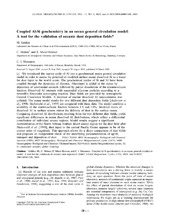Coupled Al-Si geochemistry in an ocean general circulation model: A tool for the validation of oceanic dust deposition fields?
Peer reviewed, Journal article

View/
Date
2003-03-19Metadata
Show full item recordCollections
- Geophysical Institute [1185]
Original version
https://doi.org/10.1029/2001gb001549Abstract
We introduced the marine cycle of Al into a geochemical ocean general circulation model in order to assess the potential of modeled surface ocean dissolved Al as a tracer for dust input to the world ocean. The geochemical cycles of Si and Al have been coupled through the dynamics of diatoms. Aluminum is added to the ocean by deposition of continental aerosols followed by partial dissolution of the aluminosilicate fraction. Dissolved Al interacts with suspended siliceous particles according to a reversible first-order scavenging reaction. Dust fields are provided by Atmospheric General Circulation Models. A database of marine dissolved Al measurements was collated. The ocean model results for two different dust deposition fields [Andersen et al., 1998; Mahowald et al., 1999] are compared with these data. The model confirms a solubility of the aluminosilicate fraction between 1.5 and 3.0%. Modeled levels of dissolved Al in surface waters mirror the delivery of dust to the surface ocean. Comparing dissolved Al distributions resulting from the two different dust fields, yields significant differences in ocean dissolved Al distributions, which reflect a differential contribution of individual source regions. Model results suggest a significant overestimation of the North African-Arabian desert source region for the dust field after Mahowald et al. [1999]; dust input to the central Pacific Ocean appears to be of the correct order of magnitude. This approach allows for a direct comparison of dust fields and proposes an independent check of the underlying parameterization of uplift, transport and deposition of dust.